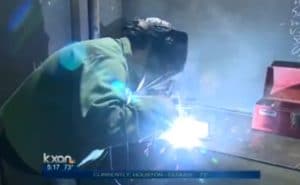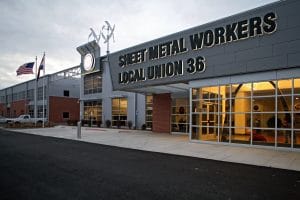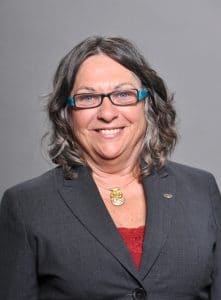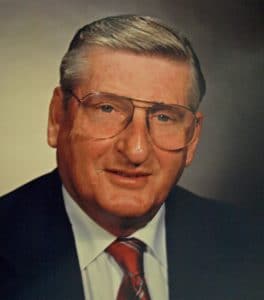John Helak, Business Manager / FST of Local 71, Buffalo, New York, was appointed to SMART’s General Executive Council as a General Vice President, effective August 14, 2013.
Brother Helak began his career in the sheet metal industry as an apprentice in 1978. He served as a benefits trustee from 1992-1994 and E-board member from March 1995 until his appointment as an Organizer in June1995. He was elected as Business Representative in 1997, serving in that position until his election as Business Manager /FST in 2003.
John served as a trustee of the Niagara County Building trades from 1998 to 2003 and a Trustee of the Buffalo Building Trades from 2003 to present. In 2011, he was appointed to the Best Practices Committee and in 2012 was elected President of the Metropolitan Association.
Author: paul
 Amanda York was looking for job security after graduating.
Amanda York was looking for job security after graduating.
She’s one of a few dozen apprentices with the Sheet Metal 67 Union in east Austin.
“Here we’re practicing our three pass weld,” said York.
Amanda wants to be a welder.
And she’s getting the opportunity to learn her trade for free.
“Well you can think of the apprenticeship as a scholarship,” said Michael Kramm, Training Coordinator Sheet Metal 67.
How it works is anyone who is a high school graduate and 18 years old – can learn the sheet metal industry for free and get paid while working as an apprentice. Click here for more

http://www.mydaytondailynews.com/videos/news/sheet-metal-training-offered-at-no-cost/vCFXqW/

“I think the hardest part is the sizes and weights of the material that you work with because as a woman you’re not as strong as a man so sometimes it can be a bit challenging to try and lift something up and carry it up a ladder and try and install it over your head,” said Fatima Ware.
Fatima is three years into the five year program and what’s her motivation? “To be better, to try to be better than the men. . .” Click here for more coverage from WOIO Action News in Cleveland.

The event will showcase the cutting edge training, skills, and knowledge that have kept the unionized sheet metal industry at the forefront of the building and construction trades for more than a century.
At local JATCs, the public will be able to tour the facility, speak one on one with instructors and learn about the unionized sheet metal industry, our accredited training programs and rewarding career opportunities for graduates. Union representatives will also be available to discuss new affiliations with local employers, colleges, and trade schools.
Featured events will be held at these locations.
Please contact Paul Pimentel at ppimentel@smart-union.org or 202 662-0812 for more information.

Born in the Bronx, NY, of immigrant parents, Morr comes from a family of union workers. “My father was a union painter and my mother and aunts worked in sweatshops as young children from 5 a.m. until 7 p.m. every day. My mother and my aunts helped start the International Ladies’ Garment Workers’ Union. In the 20s and 30s, unions were different and people had to lay their lives on the line just to get a basic worker right, like being able to use a restroom,” Morr said.
Morr completed three years at Hunter College, with a major in sociology. After leaving school, she began working for Air Canada Airlines in ticketing and ground support. After settling in Santa Cruz, CA, she returned to school at the University of California, Santa Cruz.
Morr started driving buses in 1982 for the Pajaro Valley Unified School District. In 1989, she moved on to the Santa Cruz Metropolitan Transit District, where she is still employed. In 1990, she and 60 other operators were furloughed due to the economic downturn. Having the longest seniority, she returned to work 10 months later. It took four years to get the others back to work and it was this instance that began her interest in unions and how they worked.
Morr became interested in the affairs of UTU Local 23 in Santa Cruz. “I swore that no one would be treated the way I and my co-workers were being treated during that furlough time,” she said. Morr used her furlough time as a volunteer for Rainforest Futures, a nonprofit, grassroots organization started by Santa Cruz residents. She helped organize a group of indigenous people from Brazil to come to the United States to speak at the United Nations. She assisted with their struggle to halt the damage to the rainforests and its inhabitants.
Morr was elected legislative representative of Local 23 in 1995 and general chairperson in 2000. She was elected alternate vice president-bus by delegates at the UTU convention in 2007 and elected vice president by delegates at the UTU convention in 2011.
She has continued to pursue coursework from the National Transportation Institute and labor classes at the University of California Berkley. She has also completed training at the Federal Mediation and Conciliation Service as both a mediator and an arbitrator. She has been involved in transportation task forces to improve public transportation and has worked to pass federal legislation on transportation-safety issues. She continues to lobby for both state and federal funding and legislation for transit. She has served as vice president of the Monterey Bay Central Labor Council.
Morr has been married to her husband Loren for 36 and they have a son, a daughter and three grandchildren. The family resides in Santa Cruz.

February 10, 1931 – October 6, 2013
Lawrence “Larry” Cassidy, Retired General Secretary-Treasurer of the Sheet Metal Workers’ International Association and a third generation Sheet Metal Worker, died at his home at The Villages in Florida on October 6, 2013. His career spanned some 37 years as an active member, retiring in October 1994. He was initiated into Local 12, Pittsburgh, PA in 1957 after serving in the U.S. Marine Corps during the Korean War. He served on the local’s executive board; was Recording Secretary and President; and elected as Business Agent over the period, 1961-1973. He served as Executive Assistant to the International’s General President from 1974 until his appointment as General Secretary-Treasurer in 1989.
Brother Cassidy was well known throughout the labor movement, on Capitol Hill, and in the construction industry. He was one of the initial trustees on the sheet metal and air conditioning industry’s National Training Fund, now the International Training Institute). He was a leading supporter of DAD’s Day, raising funds for the Diabetes Research Institute in Miami, FL. He played a key role in overseeing the International’s year-long Centennial Celebration in 1988.
Larry Cassidy was pre-deceased by his wife, Millie, and their son, Kenneth, and is survived by daughters Lynn and Kathleen (Executive Secretary to the current General Secretary-Treasurer of the Union) and son, Kevin, a journeyman Sheet Metal Worker in Local 100, Suitland, MD.
His family has asked that memorial contributions be made to the Sheet Metal Workers’ International Association Scholarship Foundation, 1750 New York Avenue, N.W., Washington, D.C. 20006.

The Washington-based railroad, which has never made money, gets 12 percent of its operating budget and most capital and debt-service funding from U.S. appropriations funneled through the Transportation Department. Some are scheduled to be paid quarterly while others are reimbursements, all of which have been cut off for now.
Read the complete story at Bloomberg News.

“We have made steady and consistent progress, but it is time we commit ourselves to end food and beverage losses once and for all,” said President and CEO Joe Boardman. “Our plan will expand initiatives that have worked, add new elements and evolve as updated information and opportunities lead us to better solutions.”
Amtrak Inspector General Ted Alves agrees improvements have been achieved and testified before Congress that “over the last several years, Amtrak has taken action to reduce food and beverage losses and improve program management controls and these efforts have yielded benefits. We believe opportunities remain for further improvement.”
In inflation adjusted dollars, the Amtrak food and beverage loss is down $31 million, from $105 million in fiscal year 2006 to a projected $74 million in fiscal year 2013 – or about a 30 percent move in the right direction.
Boardman explained that approximately 99 percent of the food and beverage loss is reported from the long-distance trains that Congress requires Amtrak to operate, specifically costs associated with the dining car service. Cafe car services across the system, on the other hand, essentially break even or make a positive contribution to the bottom line.
The centerpiece of the plan is an improved management structure that consolidates operations and accountability for food and beverage into a single department. This new organization also establishes a long-distance services general manager and route directors responsible for profit and loss of specific trains who will identify opportunities for further cost savings and efficiencies.
Some of those opportunities include: aligning dining car staffing with seasonal changes in customer demand; establishing metrics to assess service attendants’ onboard sales performance; reducing spoilage; closely tracking onboard stock levels; regularly refreshing menus; and exploring new pricing and revenue management options to align with customer needs and enhance cost recovery.
Further, Amtrak is using technology onboard trains aimed at improving customer service, automating financial and other reporting, and eliminating the error prone and time consuming method of manual data entry. Just this week, for example, Amtrak began a pilot on the Silver Meteor (New York-Miami) long-distance train to test a new touch-screen tablet-based solution that dining car service attendants use to take passenger orders and print customer receipts.
In 2014 Amtrak will roll out its Point of Sale (POS) system across its national network. Currently in operation on Acela Express and California trains, POS technology improves the customer experience by streamlining the check-out and receipt printing process in café and lounge cars, and allows onboard employees more time to focus on sales and customer service. It also provides real-time inventory status, better decision support and more flexibility to introduce targeted pricing and discounts, including value and combo meals.
Also in 2014 Amtrak plans to test “cashless” sales for food and beverage on certain routes. The elimination of cash reduces transaction time and significantly reduces accounting expenses and the risk of fraud or abuse. In addition, many venues that have pursued similar initiatives have seen increased sales. This model is very popular in the airline industry and has been seen as a favorable change by travelers.
“I am confident Amtrak will succeed in this effort just as we have in other areas and across a wide range of financial and operating performance metrics,” he said, noting records for ridership, ticket revenues, and on-time performance as well as significantly reducing corporate debt and the amount of federal operating support.
If Amtrak were to eliminate food and beverage services as some observers recommend, the railroad would actually lose more money because of the loss in associated ridership and ticket revenue, and thereby increase its dependence on federal support, he stated.
Sharon Spitler had every intention of taking her life when she left her motel room in the early morning of Sept. 25.
At 6:40 a.m., the 56-year-old Westland, Mich., woman walked to the nearby South Shore railroad tracks and stood between the long twin rails that disappear in both directions in The Pines. With a fast-approaching westbound South Shore passenger train heading her way, Spitler turned her back to it.
Read the complete story at the Post-Tribune.